Living Artefacts: Conceptualizing Livingness as a Material Quality in Everyday Artefacts
Elvin Karana 1,2,*, Bahareh Barati 1, and Elisa Giaccardi 3
1 Department of Sustainable Design Engineering, Delft University of Technology, Delft, the Netherlands
2 Centre of Applied Research for Art, Design and Technology, Avans University of Applied Sciences, Breda, the Netherlands
3 Department of Human-Centered Design, Delft University of Technology, Delft, the Netherlands
Biodesign suggests the integration of living organisms, such as bacteria, algae, fungi, and plants, into design, prevalently as material sources. Designers mobilize livingness of organisms at the design time (e.g., their grow-ability into predefined forms, their ability to release colour in growth, etc.), for achieving a minimal ecological footprint and novel material expressions. The design outcome is a non-living artefact with material qualities comparable to the convention (e.g., leather-like, foam-like). Livingness, however, can be prolonged to the use time of artefacts so that the design outcomes go beyond being a mere sustainable material alternative or a unique material expression. Instead, within their unusual ways, such artefacts offer novel responsive behaviour and interaction possibilities, and new ways of doing and living, while raising critical questions about care, symbiosis, cohabitation, and adaptation. In this article, we propose the concept of living artefacts, where livingness is understood as a biological, ecological, and experiential phenomenon. To support this understanding, we propose three principles—Living Aesthetics, Mutualistic Care, and Habitabilities—as fundamental loci of designing for livingness. We illustrate the three principles with a number of cases that help articulate a finer-grained understanding of their applicability in biodesign practice.
Keywords – Biodesign, Livingness, Living Materials, Materials Experience, Design Framework, Living Artefacts.
Relevance to Design Practice – What if our everyday artefacts were alive: could sense, grow, adapt, and eventually die? How would we live with them? Conceptualizing livingness as a material quality of everyday artefacts, we propose a framework to discuss how we would experience and attend to the livingness of such artefacts in everyday life.
Citation: Karana, E., Barati, B., & Giaccardi, E. (2020). Living artefacts: Conceptualizing livingness as a material quality in everyday artefacts. International Journal of Design, 14(3), 37-53.
Received May 7, 2020; Accepted Aug. 29, 2020; Published Dec. 31, 2020.
Copyright: © 2020 Karana, Barati, & Giaccardi. Copyright for this article is retained by the authors, with first publication rights granted to the International Journal of Design. All journal content is open-accessed and allowed to be shared and adapted in accordance with the Creative Commons Attribution-NonCommercial 4.0 International (CC BY-NC 4.0) License.
*Corresponding Author: E.Karana@tudelft.nl
Elvin Karana is Professor of Materials Innovation and Design in the Faculty of Industrial Design Engineering at Delft University of Technology, where she founded and directs the Materials Experience Lab. Giving emphasis to materials’ role in design as experiential and yet deeply rooted in their inherent properties, Elvin explores and navigates the productive shifts between materials science and design for materials and product development in synergy. In 2019, she founded the creative biodesign research lab Material Incubator, that aims at designing materials that incorporate living organisms, and exploring their potential in fostering an alternative notion of the everyday. Material Incubator brings together researchers and practitioners from Avans University of Applied Sciences and Delft University of Technology.
Bahareh Barati is a postdoctoral design researcher in the Faculty of Industrial Design Engineering at Delft University of Technology. Bahareh received her MSc (cum laude) in Integrated Product Design from Delft University of Technology and was named Best Graduate of the Faculty of Industrial Design Engineering in 2012. She received her PhD in 2019 from Delft University of Technology. In her PhD work she developed strategies, tools and exemplars to unpack the potentials of smart material composites, specifically focusing on light-emitting materials and their performative qualities. She disseminated her work at design and ACM conferences such as CHI, in international journals, and at exhibitions such as Dutch Design Week. Her current research and educational activities bring into focus the unique qualities of smart and biological materials in designing and prototyping performative and adaptive products.
Elisa Giaccardi is Professor and Chair of Post-Industrial Design at Delft University of Technology, the Netherlands, where she leads the Connected Everyday Lab. She also holds a position as Guest Professor of Post-Industrial Design at the Umeå Institute of Design, Sweden. After work in metadesign, collaborative and open design processes, Elisa’s recent research engages with digital things in new ways from the starting point that contemporary things now hold both perception and possible agency (e.g., AI) and thus participate in design and use in ways that previous industrially produced objects could not. She is the editor of the book Heritage and Social Media: Understanding Heritage in a Participatory Culture (Routledge, 2012).
Introduction
In 2013, Carole Collet curated an exhibition, entitled Alive: New Design Frontiers, aimed at presenting a new design landscape, in which biology and design come together to explore an alternative design perspective with living organisms, namely biodesign (Collet, 2013; Myers, 2012). The exhibition was a quest for different kinds of ecological design models to create and unravel a future hybrid world, where our everyday products and manufacturing tools will be alive. Since then, the number of design exhibitions (e.g., Nature, Cooper Hewitt Design Trienalla with Cube Design Museum, New York, 2019; Designing the Living [La Fabrique du Vivant], Centre Pompidou, Paris, 2019), conferences (e.g., Biofabricate, New York and London, since 2014 (https://www.biofabricate.co); Alive.Active.Adaptive, Rotterdam, 2017 (Karana, Giaccardi, Nimkulrat, Niedderer, & Camere, 2017), as well as the establishment of online communities and biodesign labs (see Karana, 2020 for an extensive overview) has remarkably increased.
Today, technological and economic opportunities, alongside its ecological benefits, suggest biodesign as a new industrial paradigm for the production of artefacts in the 21st century (Ginsberg & Chieza, 2018; Holt et al., 2012; Lelivelt, Lindner, Teuffel, & Lamers, 2015; Mironov et al., 2009). For example, Faber Futures, founded by Natsai Audrey Chieza, in collaboration with Professor John Ward and his synthetic biology lab at University College London, developed several dyeing methods with a pigment-producing bacterium called Streptomyces coelicolor. The bacteria are grown directly onto textiles, generating pigment molecules that attach themselves to fibres without the use of chemicals, consuming 500 times less water than normal industrial processes. Following this, in collaboration with Ginko Bioworks, Chieza was able to scale up this technique for large-scale textile patterns and prints (Figure 1, upper). Another recent example is mycelium-based composite tiles, produced by MOGU, based on growing selected strains of mycelium (the vegetative stage of mushrooms) on pre-engineered substrates made of agro-industrial residues. MOGU scaled up their production process and launched their first series of acoustic panels and tiles in 2019 (Figure 1, below). In these two examples, designers collaborate with living organisms, guiding their growth, and creating the conditions in which the desired material outcome is achieved (see for other examples, Camere & Karana, 2018; Myers, 2012). They mobilize the livingness of organisms at the time of design, i.e., in the design and fabrication of material artefacts for minimum ecological footprint, while fulfilling novel material expressions and functions. Hence, living organisms are integrated into design primarily as material sources and the design outcome is a non-living artefact offering sustainable material alternatives to the conventional ones (e.g., polystyrene foam).

Figure 1. Two biodesign examples which suggest new ways for the production of artefacts: upper, Assemblage 001, textile dyed with bacterial pigment by The Faber Futures x Ginkgo Bioworks, residence 2017, photography by IMMATTER Studio; below, mycelium-based tiles by MOGU.
Livingness, however, can be prolonged to the use of artefacts. Then, living artefacts can act as energy and food generators, bio-sensors, light sources, water and air purifiers, heat regulators, etc. Living Things is one such example where the organism, in this case, microalgae, is integrated into furniture pieces (Figure 2) and continues to live in the use time. The idea is that the living vessels recycle light, heat, and carbon dioxide from buildings and their inhabitants into rich green biomass which can be consumed as food or feedstock. The designers illustrate an enduring symbiotic relationship between human and photosynthetic algae, in which both are mutual beneficiaries.

Figure 2. "Living Things" explores symbiotic relationships with living organisms through furniture that cultivates spirulina algae by Jacob Douenias, Ethan Frier, and Lena Tesone. Image credits: Tom Little, Courtesy of the Mattress Factory.
When organisms are still alive in the material outcome of the design process and their envisaged usage is extended to the use time, livingness becomes a persistent material quality in design, and the design outcome is a living artefact. While practical and methodological challenges of designing with living organisms (e.g., Camera & Karana, 2018; Karana, Blauwhoff, Hultink, & Camere, 2018; Pataranutaporn, Vujic, Kong, Maes, & Sra, 2020; Sawa, 2016), sustainability-related premises (e.g., Jones, Huynh, Dekiwadia, Daver, & John, 2017; Jiang, Walczyk, Mooney, & Putney, 2013) and the possibilities for unique design expressions (Camera & Karana, 2018; Ginsberg, 2013; Karana et al., 2018; Parisi & Rognoli, 2017) have attracted scholarly attention to date, relatively little is known when the livingness becomes a quality of everyday artefacts: How do we live with living artefacts? How do we experience and attend to their livingness?
Bringing livingness into the use time of artefacts is not new. Biophilic design in architecture has been striving for increased human connectivity to nature by leveraging or inserting instances of nature or natural patterns into the built environment. The theory on biophilia (Kellert & Wilson, 1993; Wilson, 1984) explained aspects of human psychology with regards to our attractions and positive emotions towards organisms, species, habitats, processes, and objects in their natural surroundings. These psychological benefits, alongside sustainability, have motivated many designers to practice biophilic design. In most instances, designers replicate naturalistic experiences (Kennedy, 2017).
Unlike biophilic design examples, in Living Things the creative outcome goes beyond being a mere sustainable alternative or naturalistic expressions to connect to nature. Instead, Living Things (and other examples which will be addressed in the next sections) suggests, within their unusual ways, responsive behaviour and interaction possibilities, new ways of doing and living, raising critical questions concerning care, symbiosis, cohabitation, and adaptation.
This paper is a first attempt to develop a design framework which introduces livingness as a material quality in everyday artefacts that sense, grow, adapt, and eventually die. The proposed framework discusses how we would experience and attend to the livingness of an artefact in everyday life. After a literature review on biodesign, we will present livingness as a biological, ecological, and experiential phenomenon. From these sections, we will derive three principles of our framework to design for livingness. Then, we introduce a number of example design cases from the last two decades, which we analyze based on the three presented principles of our framework that helps articulate a finer-grained understanding of their applicability in design practice. In the discussion, we will address the unique contribution of our framework to the field of biodesign, as well as the challenges and further implications of living artefacts for design research and practice.
Designing with Living Organisms
The cross-fertilisation of biology with art, architecture and design offers diverse forms of expression and suggests new sustainable ways of fabrication in design (Camere & Karana, 2018; Collet, 2017; Ginsberg, Calvert, Schyfter, Elfick, & Endy, 2014; Myers, 2012). Largely framed under the notion of biodesign (Myers, 2012), this emerging practice suggests a co-creation of artefacts between humans and living organisms; using organisms such as algae, fungi, bacteria, and plants, as building blocks, material sources, energy generators, digital storage systems, air purifiers, and more. Biodesign builds upon the relatively established field of biofabrication, which has a long history in biomedical science and engineering (Fujii, Yoshida, & Sugimura, 2016; Mironov et al., 2009; Pavlovich, Hunsberger, & Atala, 2016). Today, potential applications of biofabrication vary from organ printing and energy production (biofuels from algae, for example), to animal-free leather and fur-like materials (such as MycoWorks’ fungi-based leather), and oil-free plastic and foam alternatives (Bloom Algae Foam, for example).
In biodesign, many designers use renewable resources as feeding elements for the living organisms (Holt et al., 2012; Lelivelt et al., 2015). In addition, biodesign processes involve a limited amount of additional energy, because they harness the metabolic abilities of growing biological systems to produce materials (Jiang et al., 2013; Jones et al., 2017). Technological and economic opportunities, alongside its ecological benefits, point to biodesign as a new industrial paradigm for the production of artefacts in the 21st century (Ginsberg & Chieza, 2018; Holt et al., 2012; Lelivelt et al., 2015; Mironov et al., 2009).
While this transition towards more sustainable production systems and materials in design is a complex and long-term endeavor, recent initiatives for scaling up with living organisms are promising. Ecovative, MycoWorks, MOGU, and Modern Meadow are just a few initiatives that have been successful in creating commercial applications from living materials and launched businesses for the mass production of biofabricated artefacts. From a recent interview study, with several of these names, it is clear that concerns regarding sustainability are the main driver behind designers’ ambitions to integrate living materials into their design processes (Camere & Karana, 2018). Alongside sustainability, other design potentials in relation to unique form expressions and agency of living materials in the making have inspired many designers over the last decade. “…designers perceive their practice as co-performed with an organism that has an agency of its own. When working with living systems, designers negotiate the final form of an artefact with a highly responsive material, an alive one, which limits the intentionality of designers and makes the outcome unpredictable” (Camere & Karana, 2018, p. 579).
Camere and Karana (2018) provide an overview of these design attempts which vary from speculative examples to commercial applications under four categories: augmented biology, in which designers seek the re-engineering of cells to design new biological organisms that can help us cope with contemporary societal challenges, such as famine, diseases and energy shortages (Agapakis, 2013; Collins, 2012; Ginsberg et al., 2014); biodesign fiction, where designers speculate on the implications of biotechnological futures before they happen through scenarios or prototypes (Ginsberg et al., 2014); digital biofabrication, in which designers couple biological tools with advanced computer technologies (see for example, Bader et al., 2016); and growing design, which is characterized by hands-on practice, focusing on the development of novel materials for product design (Camere & Karana, 2017; Ciuffi, 2013; Montalti, 2010).
Most of the biodesign examples can be categorized at the intersection of two or more categories presented above. Nevertheless, when it comes to living artefacts which extend the life of organisms to the use time, examples which go beyond speculation are limited.
Livingness as a Biological, Ecological, and Experiential Phenomenon
From philosophy to science, the definition of life and living has puzzled scholars since time immemorial. While some described living as a self-sustaining chemical system capable of undergoing Darwinian evolution (Joyce, 2012), others related living to the ability to reproduce, life is self-reproduction with variations, for example (Trifonov, 2011; see, also, Hansma, 2012; Popa, 2004). From here, we pose the question: what if livingness was a quality of materials in everyday artefacts? In this section, looking at diverse accounts from biology to philosophy, we will describe what livingness entails as a material quality in everyday artefacts.
Livingness as a Biological Phenomenon
In 1972, Chilean biologists Humberto Maturana and Francisco Varela introduced the term autopoiesis (from Greek auto, meaning self, and poiesis, meaning creation, production) to define the self-maintaining chemistry of living cells, alongside other systems, which are autonomous and operationally closed, in the sense that there are sufficient processes within them to maintain the whole (Maturana & Varela, 1972). Biochemist Koshland (2002) introduced seven essential pillars by which a living system operates: Program, Improvisation, Compartmentalization, Energy, Regeneration, Adaptability, and Seclusion. On a similar account, in their article, where they compare a living organism to a man-made machine or computation, Davies, Rieper, and Tuszynski (2013) emphasize that in order to maintain their biological functions, as like machines, living organisms perform numerously complicated, synchronized, and very specific tasks (e.g., replication, respiration, metabolism). They need a steady supply of energy to be converted into such cellular functions and to maintain homeostasis (Karp, 2016). The chemical energy that organisms need comes from nutrients (i.e., food), which consists of organic molecules that store energy in their chemical bonds. Based on where they obtain the energy and carbon they need for fabricating cellular materials from, they are classified as phototrophs (which use sunlight as the energy source; e.g., plants, algae, and some bacteria) and heterotrophs (which use organic nutrients as an energy source; e.g., animals and fungi) (Nelson & Cox, 2005).
The most widely accepted definition of living from molecular biology (Karp, 2016), provides us with a practical tool to relate to the requirements of living artefacts to be kept alive. Accordingly, living organisms are open systems that survive by transforming energy and decreasing their local entropy (Davies et al., 2013), to maintain a stable and vital condition defined as homeostasis (Modell et al., 2015). There are seven characteristics common to all living organisms (Jones & Jones, 2014). Living organisms take in nutrients from their surroundings, such as proteins, carbohydrates, and fats, that they use for growth or to provide energy, which is called Nutrition. They break down food within their cells to release energy, which is Respiration, for carrying out processes, such as Movement. All living organisms move, e.g., movement of plants. However, the magnitude of their movement is different and may not be easy to visualize in all living organisms. Living organisms Excrete, which is “…the removal of toxic materials, the waste products of metabolism and substances in excess from the body of an organism” (Jones & Jones, 2014). All living organisms grow in cell number and size, which is called Growth. In order to produce new cells, organisms use food. Reproduction is another quality common to all living organisms, which is the ability to produce offspring. Last but not least, “…all living things are able to sense and respond to stimuli around them such as light, temperature, water, gravity and chemical substances” (Jones & Jones, 2014), which is called Sensitivity.
In line with this description, from a technical standpoint, livingness as a design quality requires the state or quality of being alive and exhibiting the seven biological characteristics listed above. Thus, if artefacts possess livingness as a quality, they will have the unique ability to: grow, metabolize, respond to external stimuli, reproduce, move and respire, and, ultimately, adapt to their environment.
Livingness as an Ecological Phenomenon
In this section, we discuss how livingness can also be considered as a broader ecological phenomenon. To do so, we look at accounts from biology and philosophy, and how these have influenced the design discourse to date.
On a biological account, the type of natural environment in which a particular organism will thrive is called habitat, which might be a geographical area, a rotten cheese, a rock, or a body (for a parasitic organism). Some organisms are more tolerant of wide variations within a habitat, while others are very specific in their requirements. Yet, the chief environmental factors affecting the distribution of all living organisms are temperature, humidity, climate, soil type, and light intensity (Karp, 2016).
Living organisms cohabit with other living things within an ecosystem. This living together of unlike organisms refers to the notion of symbiosis, which was first coined by Albert Bernhard Frank in 1877 to describe the mutualistic relationship in lichens (Wilkinson, 2001). Symbiosis can take different forms. It can be mutualistic, all partners benefit, or commensalistic, one benefits and the others continue to live unharmed, or parasitic, one benefits but the other one (the host) is harmed (Wilkinson, 2001). In symbiosis, relationships may shift gradually or abruptly along the continuum (Dimijian, 2000), yet there are always interactions, adaptations, movements of energy, the abundance and distribution of organisms, and biodiversity (Malmstrom, 2010). The symbiotic interactions (Douglas, 1994) can involve individuals of the same species (i.e., intraspecific interactions) or individuals of different species (i.e., interspecific interactions). These interactions can be further described and classified by the mechanism of the interaction or the strength, duration and direction of their effects (Isaac, 1992). Thus, as described by Levin (1998), ecosystems are complex adaptive systems in which living organisms form self-organizing patterns across different scales of time and space.
In Science and Technology Studies (STS) as well as more generally in philosophy, Kirksey and Helmreich (2010), in their essay entitled The Emergence of Multispecies Ethnography, introduce the idea of multispecies ethnographers who study the host of organisms whose lives and deaths are linked to human social worlds. In line with that, they explain the notion of becomings as new kinds of relations emerging from nonhierarchical alliances, symbiotic attachments, and the mingling of creative agents (cf. Deleuze & Guattari, 1987). In When Species Meet, Haraway (2008) notes a species turn in anthropology, and states: “If we appreciate the foolishness of human exceptionalism, then we know that becoming is always becoming with—in a contact zone where the outcome, where who is in the world, is at stake” (p. 244). Accordingly, scholarship addressing the human interaction with plants, animals, and other life forms has increasingly addressed multispecies assemblages (Kirksey & Helmreich, 2010) and collaborative survival networks (Haraway, 2008), which entails both “… hermeneutic understanding and interpretation (humanism) as well as explanations in terms of causal mechanisms and historical understanding (naturalism)” (Morris, 2014, p. 51). Some new materialist figures such as Karen Barad and Jane Bennet share similar approaches, calling for, for example, performativity (Barad, 2003) by suggesting to expand the performative beyond the social (human) to the material aiming to show that material things are productive (Bennet, 2010), and play an active role in public life.
In design, scholars also have begun to advocate for a more-than-human turn in the understanding and design of human relations with both natural and artificial entities on ecological grounds. This term situates itself at the intersection of biological, social, political and cultural modes of analysis and is associated to a variety of notions, such as natureculture, cohabitation, and hybridity (Smith, Bardzell, & Bardzell, 2017), posthumanism in design (DiSalvo & Lukkens, 2011) and more-than-human design (Clarke et al., 2019; Coulton & Lindley, 2019; Giaccardi & Redstrom, 2020). These accounts show similarities with biosemiotic approaches, which describe the basic characteristics of living things as their being active agents with autonomous subjectivity and intentionality which relates to their purpose-oriented actions carried out to be competent with the situation concerned (Barbieri, 2007; Hoffmeyer, 1996; Kawade, 1996, 2009; Sebeok & Umiker-Sebeok, 1992).
In line with these accounts, livingness as a design quality requires from an ecological standpoint the careful crafting of cohabitation, intra/interspecies interaction, and their relation to other non-living entities (e.g., soil or computational artefacts) within an ecosystem.
Livingness as an Experiential Phenomenon
In this section, we discuss how livingness would be experienced and how designers might elicit such an experience through the careful crafting of the material qualities of the artefact.
Livingness has long been a literal element in design by inserting instances of nature or natural patterns into artefacts, as like in biophilic design. Hence, many designers purposefully designed for connectivity with nature through living elements like plants and trees. Herein, livingness has been discussed mainly as an aesthetic experience (in a narrow sense), mostly in relation to a naturalistic expression (Caperna, Cerqua, Giuliani, Salingaros, & Serafini, 2010), referring to the realization of shapes and geometries which directly (e.g., sunlight, ecosystems, etc.), indirectly (e.g., using fountains), or symbolically (e.g., through images) reflect and support the natural affinity between human beings and nature.
Livingness has also been a resource for inspiration in design for creating alive-like expressions emulating structures and behaviours of living organisms. Alive-like expressions have been achieved through dynamic, kinetic, and responsive features, often by integrating electronic components and actuators. For example, the Shylight installations by Studio Drift are inspired by the rhythmic nastic movement of higher plants in response to the onset of darkness.

Figure 3. Alive-like expressions in the Shylight installations by Studio Drift.
Next to integrating actuators in kinetic systems, there are examples where researchers tap into the responsive capacity of natural and engineered materials in creating living-like movements. For instance, the work of Menges and Reichert (2012), Hygroscope, exploits unique hygroscopic characteristics of wood in programming and fabricating wood veneer materials that change shape when absorbing moisture from their environment (Figure 4, upper). Another example of living-like movement is the BioLogic responsive textile project from MIT-Tangible Media Group (Figure 4, below). The design incorporates once-living bacterial cells, which react to body heat and sweat, enabling sweat to evaporate through dozens of tiny triangular flaps (Yao et al., 2015). In both Hygroscope and BioLogic, the kinetic alive-like expressions are pre-programmed by relying on the responsive capacity of the natural systems, which makes them act as a smart material, with no need for the supply of external energy and mechanical or electronic control.

Figure 4. Harvesting the responsive capacity of non-living and living biological sources: upper, Hygroscope by Menges and Reichert (2012), image credits: ICD University of Stuttgart; below, BioLogic by MIT-Tangible Media Group (Yao et al., 2015).
The dynamic qualities of smart and living materials alike have been reflected in the theoretical discourse on materials experience (Bergström et al., 2010; Karana, Nimkulrat, Giaccardi, Niedderer, & Fan, 2019). Smart materials refer to a diverse group of engineered materials with the ability to dynamically respond to specific external stimuli. Given that the dynamic and responsive behaviour of smart materials can only unfold over time, temporal form becomes an important element of materials experience (Barati, Karana, & Hekkert, 2019; Mazé & Redström, 2005; Vallgårda, Winther, Mørch, & Vizer, 2015). Bergström et al. (2010) put forward the concept of becoming materials, referring to the temporal capacity of smart materials to assume multiple aesthetic expressions that unfold only over time and in context. Karana et al. (2019) suggest a similar understanding of living materials as dynamic and temporal, open to change at both design and use time.
Advancing our theoretical understanding of materials experience, Giaccardi and Karana (2015) stress the active agency of materials in shaping not only the aesthetic dimension of individual experiences with the materials of artefacts but also social practice. This performative dimension of materials experience is illustrated in Karana, Giaccardi, Stamhuis, and Goossensen (2016) through the journey of a designer who explores alternative performances for how to tune a radio (e.g., kneading), by relating the expression of possible actions to the performative qualities of a range of materials (such as squeezy rubber). Bringing further attention to performative acts in the design of materials experience, Barati, Giaccardi, and Karana (2018) describe the making process of electroluminescent materials as the result of tinkering with the matter, structure, form, and computation of such materials. These are manipulated to deliberately disrupt the affordance of the material, with the goal to explore unanticipated action possibilities and materialize the performative qualities of the designed samples. In another study, Karana et al. (2018) illustrate how a new-fangled mycelium-based composite offers a new practice for unpacking (wine) bottles, by inviting its user to pluck and pick the material to reveal its contents. The qualities of the material are particularly fine-tuned to trigger these actions. All in all, the vibrant character of living materials and their adaptive nature in the context of use ask for a theoretical deliberation over what materials make us do, i.e., their performative qualities.
In line with these accounts, livingness as a design quality from an experiential standpoint requires the careful crafting of material qualities by taking into account the changes in a living organism over time and the specific actions they might elicit from people due to their livingness.
Towards a Design Framework for Living Artefacts
As discussed in the previous section, when it comes to designing for livingness in artefacts, there is a need to understand how designers can attend to livingness through the careful crafting of material qualities, how they can anticipate the change of a living artefact over time or the way people will relate and interact with it, and thus how they can ecologically configure its biological habitat(s) through its life-time. To support this understanding, in this section, we propose three principles for the design of living artefacts: Living Aesthetics, Mutualistic Care, and Habitabilities. Together, they represent the three fundamental loci of designing for livingness as a biological, ecological, and experiential phenomenon. They are inherently connected and should be equally attended to in the design process. Below, we illustrate these three design principles with a number of cases that help articulate different dimensions under each principle (Table 1).
Table 1. Design cases discussed to describe the three principles for the design of living artefacts.
| Image | Description | Source | |
| 1 | 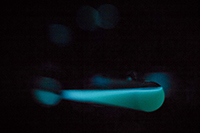 |
Ambio by Teresa van Dongen is a lamp that uses bioluminescent bacteria. Photography by Hans Boddeke. | http://www.teresavandongen.com/Ambio |
| 2 | 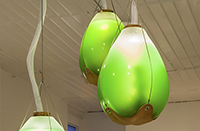 |
Living Things by Jacob Douenias, Ethan Frier, and Lena Tesone explores symbiosis with photosynthetic algae through furniture that cultivates living algae. | http://www.douenias.design/living-things-1 |
| 3 | 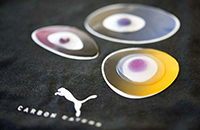 |
Carbon Eaters by PUMA and MIT Design Lab is a microbially-active t-shirt that responds to environmental factors by changing its appearance and informing the user about air quality. | https://design.mit.edu/projects/puma-biodesign |
| 4 | 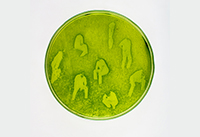 |
Algae-graphs by Lia Giraud are living portraits and detailed landscapes, produced by photosynthesizing microorganisms. | http://www.liagiraud.com/videos/cultures/ |
| 5 | 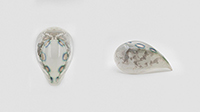 |
Vespers III by Mediated Matter group at MIT is a 3D-printed face mask inhabited by genetically modified living microorganisms that produce pigments and/or chemical substances. Image credit: Yoram Reshef. | https://www.media.mit.edu/projects/vespers-iii/overview/ |
| 6 | 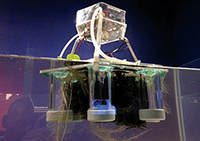 |
Caravel by Ivan Henriques is an autonomous robot that uses Microbial Fuel Cell (MFC) technology to harvest electricity from anaerobic bacteria and organic components in the water. | https://ivanhenriques.com/works/caravel/ |
| 7 | 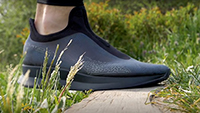 |
Breathing Shoe by PUMA and MIT Design Lab is a trainer with embedded bacteria in the upper, responsible for creating a unique pattern of air passages corresponding to heat generated by the wearer. | https://www.puma-catchup.com/charles-johnson-on-how-puma-creates-a-breathing-shoe-with-the-help-of-bacteria/ |
| 8 | 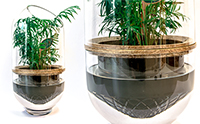 |
Living Light by Ermi van Oers is a lamp which harvests its energy through the photosynthetic process of the plant. | https://livinglight.info/about/ |
| 9 | 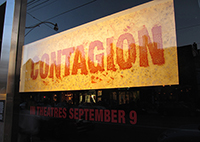 |
Contagion is a bacterial billboard, prepared to advertize Steven Soderburgh’s 2011 film Contagion. The board concept and design by Mike Takasaki and Glen D’souza from Lowe Roche, made by CURB Media, and mycologist Patrick Hickey and his team. Image credits: Michael Takasaki. | https://www.zdnet.com/article/microbial-marketing-bacteria-and-fungi-infect-contagions-billboard/ |
| 10 | 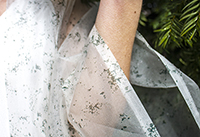 |
Biogarmentry by Roya Aghighi is a piece of clothing that combines natural fibre based textile and living photosynthetic microalgae cells. | https://www.royaaghighi.com/biogarmentry.html |
| 11 | 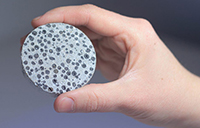 |
Bioconcrete by Henk Jonkers and his team at Delft University of Technology is a concrete material that heals itself when cracks appear thanks to the limestone-producing bacteria that are embedded in the concrete. | https://www.basiliskconcrete.com/zelfherstellend-biobeeton-tu-delft-genomineerd-voor-european-inventor-award/?lang=en |
| 12 | 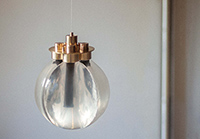 |
Spark of Light by Teresa van Dongen is an electricity-free LED lamp that is powered by living bacteria. Photography by Hans Boddeke. | http://www.teresavandongen.com/Spark-of-Life |
The selection of design cases was based on an extensive screening of various biodesign sources, including recent books (Ginsberg et al., 2014; Myers, 2012), various websites of Design Research Labs acting at the intersection of biology and design (an extensive overview is presented by Karana, 2020), design blogs (e.g., Dezeen, Designboom), journals and conference proceedings (e.g., recent CHI publications on biodesign), as well as the catalogues of recent exhibitions on biodesign, such as La Fabrique du Vivant (Centre Pompidou, Paris, 2019). We performed a content analysis of the verbal labelling and formal qualities used to describe and characterize the designed artefact as living or alive in the set of cases initially collected. Then, we first selected the realistic cases in which the organism’s livingness was maintained in the final artefact. The second cycle of analysis focused on refining our working definitions of the three principles and detecting dimensions in their practical application. We then deliberately looked for cases to further support and substantiate a finer understanding of their particular dimension and varieties. The majority of the cases presented in the paper are situated in the USA and the Netherlands. This can be partly explained by the accelerating development in these countries within the field of biodesign. We found many living artefact cases from other countries, such as the UK. Nevertheless, these are mostly in the realm of speculative design.
Our intention is not to claim that a specific case is a better example of livingness than the others. Instead, we explore how the proposed principles may apply in practice, and how we can surface and articulate the key dimensions under each principle and illuminate possibilities for different design directions.
Living Aesthetics
This principle concerns the way humans experience the type, degree, and duration of change in a living artefact over time (e.g., immediate or gradual changes in colour, form, or function). The term aesthetics is used here to indicate how aspects of livingness (i.e., change) come to expression in the artefact, and can, therefore, be experienced. Because change in living materials may evoke quite different semantic meanings and associations, this principle entails a purposeful design of change—from the initial state of a living material to the end of its life.
Two biological phenomena distinguish the aesthetics of change in living materials from non-living ones: growth and reproduction. Growth and reproduction can be characterised with the type of change concerning the sensorial qualities of living materials (e.g., colour, smell, texture), form, and movement. Contagion Advertisement is one such example which successfully illustrates an application of living bacteria and its unique temporality at use time. This microbial billboard was installed in Toronto to advertise Steven Soderbergh’s 2011 film Contagion. The board was designed by the agency Lowe Roche, CURB Media, microbiologists, and immunologists, using two large petri dishes inoculated with living bacteria including penicillin, mould, and pigmented bacteria. The bacteria grew overnight to form the logo of the film, offering a new design expression that was initiated by the designer and yet created by the organism, which grew and reproduced over time (Figure 5).

Figure 5. Changes in the surface colour and texture of the Contagion billboard as a result of bacterial growth and competition. The board concept and design by Mike Takasaki and Glen D'souza from Lowe Roche, made by CURB Media, and mycologist Patrick Hickey and his team. Image credits: Michael Takasaki.
Living organisms in the Contagion example instigate changes in terms of colour composition and texture, which becomes mouldy as various microorganisms grow and compete, as anticipated by the designers. Likewise, microorganisms contained within Vespers III, which is a series of 3D-printed masks, are responsible for the colour change in the translucent masks. The masks are inhabited by genetically modified living microorganisms that produce pigments and/or chemical substances useful for humans. Researchers behind Vespers III explain that “computational and digital fabrication tools are customized to direct the growth and expression of biological microorganisms.” The changes in colour and pattern occur over the course of days and are related to the life cycle of the microorganisms (i.e., growth and death). Change in aesthetics can also be designed considering the end of life scenarios for the living artefact. For example, in the case of Algae-Graphs, Lia Giraud has managed to culture sensitive microscopic algae which are capable of capturing and retaining properties in light, which naturally develop pictures using a technique similar to photography. The images in living portraits and landscapes vanish over time, as algae grow under homogeneous lighting.
On the other hand, there are other examples where livingness is not merely a change in material colour or texture. This is particularly the case where the (micro)organism has a sensing or power generating role in the living artefact, as if replacing an electronic component, such as a sensor or a power source. In the cases of Spark of Light, Caravel, and Living Light, the microorganisms generate electrical current and microprocessors control the activation of the transducers such as LED’s and mini fans. The temporal expression of the movement and the light output, even though not directly produced by the microorganism, is still dependent on the changing state of the organism’s livingness. The light output in Spark of Light is constant, dimming over the course of days, as the necessary chemicals in the medium deplete (Figure 6, left). In Living Light, the intensity of light increases in response to touch, creating a biosensor out of the plant leaves (Figure 6, right). Caravel uses the electricity harvested to propel itself on the surface of the water, constantly changing its location. We see visible indications of livingness through movement in Caravel, and continuous illumination in both Spark of Light and Living Light.

Figure 6. Two living artefacts in which the temporal expression of the light output is dependent on the changing state of the organism’s livingness: left, Spark of Light, dims overtime when the necessary chemicals in the medium deplete, by Teresa van Dongen; right, Living Light, the intensity of light increases in response to touch, creating a biosensor out of the plant leaves, by Ermi van Oers.
Besides the type of change and its coupling to the growth and reproduction of each specific microorganism, we see varieties in degree and duration of change among the cases. Degree concerns the extent of change in living materials, e.g., from mild and hardly perceptible to severe. Duration concerns the time during which the type of change in living materials exists or lasts, e.g., immediate or delayed, gradual, but as well whether the change is ephemeral or reversible. While in Algae-Graphs the changes are deliberately ephemeral, we encountered cases such as Bioconcrete, designed to survive for more than 200 years. By embedding limestone-producing bacteria in concrete, the Dutch microbiologist Henk Jonkers invented a concrete material that heals itself when cracks appear. Although in this example the living material is not embedded in an everyday artefact but envisioned as a construction material for bridges and buildings, it still provides us with a good reference to define the very extreme duration of livingness in an artefact, without giving any indication to its livingness through its aesthetic qualities.
In Ambio, which balances two weights and a glass tube half-filled with an artificial seawater medium containing bioluminescent bacteria, the change in light intensity is immediate and reversible, conditioned by the living culture being mixed with the overhead oxygen. The bacterial growth is inhibited over the course of a few days, due to nutrient depletion and metabolic processes (Waters & Lloyd, 1985). Instead, in the example of Biogarmentry, which is a photosynthetic living textile with microalgae, the creation or change in patterns happens gradually over time, as an indication of their livingness and eventually their end of life (Figure 7). The designer indicates the duration of change can be altered, for example, based on the substrate textile materials which are used as a scaffold (such as cotton or silk).

Figure 7. An exploration of the living aesthetics in the Biogarmentry project (by Roya Aghighi).
These examples illustrate how designers navigate between the different dimensions of living aesthetics. In all cases, for both the functional and experiential benefits to persist, designers rely on certain actions to take place. As the change in a living material indicates the organism’s wellbeing or struggle, the careful crafting of living aesthetics can help facilitate unique care-related actions in the long run.
Mutualistic Care
With this principle, we refer to a reciprocal and evolving relationship between humans and living artefacts, where humans act upon a living artefact in order for it to thrive. In return for this care, the artefact continues to provide humans with (functional) benefits, for example, by being an ambient light, an air-purifier, or an oil-free colour changing paint.
In building this mutually beneficial relationship, a variety of actions and performances upon living artefacts might be carried out as constituents of either established or novel practices. For example, in the cases of Ambio, Spark of Light, and Biogarmentry, the living artefacts ask for a variety of actions related to the organisms’ wellbeing and/or the artefacts’ function. In Biogarmentry, the designer envisions that the living textile requires humans to perform novel actions, not necessarily related to the care instruction of conventional textiles, such as cotton. The performance of spraying water onto the textile is directed to sustain the livingness of the embedded microorganisms and as such is linked to the aesthetic (e.g., colour and pattern size) and peripheral function of the textile (to purify the air). In Ambio, instead, the photobacterium used in the artefact needs to be replaced with a freshly inoculated liquid medium, partly due to overpopulation and resource depletion. Similarly, the bacterial culture in Spark of Light needs to be fed every now and then in order to keep its living function. These performances are seemingly different from what we might typically associate with maintaining a light source to function. While in most cases designers have not specified the lifetime of the living organisms or care instructions necessary for keeping them functionally alive, in the case of Biogarmentry the designer has purposely developed textile tags to guide the end-users in maintaining the livingness of the artefact (Figure 8).

Figure 8. Textile tags developed for Biogarmentry to instruct the novel care practice. Designer and image credit: Roya Aghighi.
Watering the plants, adding fertilizer to the soil, trimming the branches, and cleaning the aquarium tank are commonplace care practices for living artefacts in biophilic design. Similarly, in Living Light, the established practice of watering the plant pot is necessary for keeping the plant alive and maintaining its symbiotic relationship with the bacteria (responsible for generating electrical current) in the soil. The Living Light project, however, brings to our attention another dimension under mutualistic care, which explains whether the actions are directly or symbolically related to the livingness of the artefact. The action of caressing the leaves in Living Light is mapped to the intensity of LED lights, suggesting a mutualistic care scenario, even though the link is symbolic and the immediate response is enabled through a microcontroller. In Carbon Eaters, the actions include sticking several discs containing the microorganisms and carrying them on the body when exercising outdoors. For the microorganisms that feed on the carbon and other substances, such actions might be a critical part of their care practice.
The artefacts, on the other hand, can be intended to minimize human intervention by integrating a self-sustaining habitat to keep the organism alive in the absence of deliberate care. Clear examples of this are Vespers III, Contagion, Caravel, and Bioconcrete. The food source to maintain the microorganisms in both cases of Vespers III and Contagion is supplied within the artefact structures (e.g., microchambers, and a gigantic petri dish). The photosynthesizing Caravel uses the electricity harvested from the bacteria living in the water to propel itself, with no assistance from human users. In Bioconcrete, similarly, human intervention will not be necessary for activating the bacteria from their dormant state or keeping them alive so that they can slowly form the limestone and close the cracks (i.e., their healing function).
Whether cared for by humans or thriving without human intervention, in most examples the living artefacts require sun-light, water, air, etc. Thus, next to particular care actions, how the artefact is situated and configured in the everyday life, what other relationships with other living and non-living (e.g., the sun) entities are envisaged within its habitat might ultimately affect the material qualities of a living artefact.
Habitabilities
This principle concerns the way the human body and other living and non-living entities condition the livingness of an artefact. It requires the purposeful exploration of the abilities of things to provide a habitat both at design time and use time. To distinguish between the two habitats at design and use times, we refer to the niche habitat in which the living organisms are embodied in an artefact as first habitat, and the environment containing it in the use time as the second habitat.
At design time, the initial optimum habitat is designed by identifying the main elements, their relations and compositions which are necessary for the organism to thrive. Designing such habitats requires an understanding of the energy conservation mechanisms necessary for the primary metabolites involved in growth and reproduction, such as photosynthesis, aerobic and (an)aerobic respiration, and fermentation processes (Jurtshuk, 1996; Voet & Voet, 2006). Corresponding to each mechanism, certain sources such as light, oxygen, carbon, and nitrogen, etc., might or might not be necessary for keeping a specific organism alive. Moreover, in order to maintain the habitat, an understanding and analysis of the bio-process, including determination of biomass, growth rate, productivity, and yield among other factors should be considered (Willey, Sherwood, & Woolverton, 2011; as also briefly discussed in the biology and ecology of livingness sections). For example, in order to maintain the livingness of a bacterial culture, certain concentrations of nutrients and by-products should be sustained in its first habitat. With microbial growth, the nutrients are gradually consumed and by-products accumulate. If the culture continues, the viable cell density will decrease, leading to the inhibition of growth and/or reproduction. Algae-graph and Contagion are two examples of habitats that are not designed to maintain a viable culture, nor to regulate the supplied nutrients and by-products. The former emphasizes the ephemerality of the captured image, while the latter is a one-off living poster/billboard.
Three operational cultivation/fermentation techniques can be applied to microbial cultures in their first habitats: a batch, fed-batch, and continuous culture (Li, Chen, Chen, Wu, & Chen, 2014). In batch cultivation, microorganisms are inoculated to a fixed volume of medium, which will replace the dying culture, like in the example of Ambio. The entire process here is left undisturbed (without adding additional nutrients) once initiated. The advantages of batch processing are ease of operation and low risk of contamination. Fed-batch culture is a modified version of batch cultivation and is the most common operational technique in the bioprocess industry. Here, nutrients and fresh medium are added at regular intervals of time, resulting in a gradual increase in the overall volume. In continuous culture, fresh medium is continuously added to the fermenter or bioreactor, while used medium and cells are harvested at the same time. The overall volume thus stays the same. Living Things, which we discussed earlier in the paper, is a good example of continuous culture. Thus, the main difference between the initial habitats of Living Things and Ambio is their modes of cultivation operation when it comes to how the culture is being regulated and refreshed.
The first habitats may differ considerably from the second habitat in terms of openness and embeddedness. For example, in the case of Contagion, 35 types of bacteria and fungi were cultured on agar substrate within a closed glass display. The first habitat, in this case, is a scale-up petri dish, imitating an optimum lab environment. Likewise, in Vespers III the first habitat is a 3D-printed special case, which keeps the organism through its lifetime in a closed system. Similarly, in Ambio, the first habitat is a closed glass tube containing artificial seawater and the necessary nutrients (Figure 9). On the other hand, although relatively less, we have some examples in which the living organisms are embedded in material forms, like in the cases of Bioconcrete and Biogarmentry. In Bioconcrete, the bacteria are placed into biodegradable capsules, which are embedded in the concrete. Likewise, the microalgae strain in Biogarmentry is cultured in the textile. These two examples illustrate an open interpretation of the first habitat, rather than being a close petri-dish like system.

Figure 9. Ambio lamp’s first habitat is a closed glass tube containing artificial seawater and the necessary nutrients
(by Teresa van Dongen).
In designing the second habitat, the living artefact is envisaged to be situated within a context which includes both living and non-living entities. The initially identified elements which condition the livingness of the organism can inspire different assemblages within the second habitat, where the relations and interdependencies between the living artefact and other things are predefined by designers. For example, in Living Light and Caravel, the continuous nutrient source is provided through a symbiosis between the plants and bacteria living in the soil. In fact, in most cases, a keep-alive principle can be identified to explain the cause and effect relationship between the certain living and non-living elements. For example, in Breathing Shoe, sweat (a non-human element in the habitat, yet provided by humans) of feet causes the microorganisms to consume the food, leading to the creation of cavities. Herein, the living artefact and humans are in a specific form of relationship that reaches beyond deliberate human actions to keep the organisms alive (i.e., mutualistic care). In other words, we can talk about the habitability of the human body for this particular artefact. In Biogarmentry, for example, the living textile is also positioned on the human body, yet there is no explicit reference to the habitability of the body, which might help the organism to thrive and effectively perform the desired functions.
Discussion: A New Kind of Biodesign Thinking
By maintaining organisms alive in the tangible manifestation of a biodesign process, livingness will become a prominent material quality of the design outcome. This will bring about a new generation of artefacts that sense, grow, reproduce, adapt, and eventually die—we refer to these as living artefacts. This orientation opens up a new and exciting design space for designers to explore and harness the potentials of living organisms in search of unique functionalities, interactions, and expressions.
Attending to livingness as a quality in what is made by humans is not new. In 2009, the philosopher Mark Bedau and his co-authors introduced the notion of living technology. This refers to “technology that is [...] explained and illustrated with examples from artificial life software, reconfigurable and evolvable hardware, autonomously self-reproducing robots, chemical protocells, and hybrid electronic-chemical systems” (Bedau, McCaskill, Packard, & Rasmussen, 2009, p. 1). The authors argue that living technology includes both technology that integrates living organisms as key material components or core systems, and technology that takes living systems as an example and applies their principles to socio-technical systems. Founded in 2004, the European Centre for Living Technology (ECLT, www.ecltech.org) is an excellent example of the state-of-the-art research devoted to the study of technologies that exhibit life-like properties such as self-organization, adaptability, and the capacity to evolve. This research includes topics such as complexity and data analysis, artificial intelligence, and bioinspired design.
On a similar account, Mansy and Pohflepp (2014) give an eloquent overview of man’s endeavour to engineer living or life-like entities capable to carry out the tasks desired by humans. From animal-based technologies to the bottom-up synthetic biology attempts to build living cells from scratch, Mansy and Pohflepp (2014) use the concept of living machine to describe systems that integrate inanimate and living components and that grow, reproduce, and evolve. Ginsberg (2014) elaborates on the living machine concept with an example from the renowned genomic research institute, the J. Craig Venter Institute (JCVI). In 2003, JCVI researchers were able to synthesize a small bacterial genome, supposedly the first self-replicating species on Earth whose “parent is a computer” (Ginsberg, 2014), which was then described by Nicholas Wade in his article in New York Times in 2010 as a living machine.
Recently, Pataranutaporn et al. (2020) have introduced the idea of living bits. This is inspired by the notion of tangible bits (Isshi & Ullmer, 1997) and refers to the integration of microorganisms in, with and as computing systems. Aiming at bridging the digital and the microbial, the authors provide design elements meant to enable a novice practitioner to understand the possibilities and challenges of integrating microorganisms within interactive computational systems.
All these concepts—living machine, living technology and living bits—suggest a bridging between biological and computational intelligence either in the way in which computer algorithms exhibiting alive-like cognitive abilities are developed, or in how living organisms are programmed with computation to exhibit certain functions. However, what is referred to as a living machine or technology in previous work is different from what we describe as a living artefact. Our conceptualization refers to “artefacts” that are ecologically and socially embedded in everyday life, with emphasis on the habitual relationship between design and use in a biodesign process that is never really finished as long as the organism is alive. To our knowledge, there is no existing research operationalizing the social dimension of livingness for design and considering how this new generation of socially embedded and habituated living artefacts might foster new ways of relating and doing in everyday life. Our framework encourages designers to explore these new opportunities and promotes the emergence of new design ideals, methods, and techniques to support a kind of biodesign thinking that facilitates non-hierarchical alliances, symbiotic attachments, and the mingling of creative agents (human and non-human alike) in everyday life.
Taking this as our point of departure, we ourselves have been carrying out a number of projects over the last years, which we presented at STILL ALIVE1. Keeping organisms alive in the artificial habitats we created has been the biggest challenge we faced along this path. While some organisms were relatively easy to tackle (bioluminescent organisms, for example, which we stored in liquid culture within the final artefacts), the main challenge has been to embed organisms into material forms, as in the Biogarmentry project in which we were involved. We are aware that designing to keep organisms alive in artefacts for everyday use is first and foremost a novel scientific attempt. The research is still in its infancy. Precisely for this reason, projects bringing together designers, scientists, and engineers who share the same eagerness to advance the field are the best suited to guide biodesign in a safe and socially relevant direction (Parkes & Dickie, 2013; Sawa, 2016; Tucker & Zilinskas, 2006). We hope our article will spark new conversations between design and science communities and inspire new directions for investigations.
What we present here, however, is just one possible future for biodesign. There are other possibilities, other critical questions. For example, we have not discussed the ethical significance and debate surrounding synthetic biology (Douglas & Savelusce, 2010; Kaebnick & Murray, 2013), nor potential ethical concerns a living artefact might elicit. And we have not considered how this future relates to the fundamental change of the conceptual space designers need to develop to cope with complexity in an increasingly more-than-human world (Giaccardi & Redström, 2020). A recent editorial from the MIT Journal of Design and Science by Ginsberg and Chieza (2018), entitled Other Biological Futures, puts forward some of these critical questions and invites us to think about other biological possibilities, which we aim to elaborate on in a future publication:
Biology isn’t inherently good, safe, or kind. By imagining that biotechnology will help solve sociopolitical problems, we risk missing the opportunity to identify big, systemic changes that may be a more appropriate fix. Making stuff with biological systems simply for the sake of making stuff will likely lead to a future similar to the present, with the same ecological and social issues. That approach exposes a limit of imagination of what biodesign could be used for. […] How do we imagine other biological futures? […] What relationship with other humans would those futures enable? Who should we ask? Who gets to ask? Can biology show us other ways to imagine? (p.1)
Conclusions
In this article, we introduced the notion of Living Artefacts, in which the organisms’ livingness is maintained and prolonged to the use time of artefacts. Within their unusual ways, these living artefacts offer novel responsive behaviour and interaction possibilities, new ways of doing and living, raising critical questions about care, symbiosis, cohabitation, and adaptation. To support this understanding, we proposed three principles for the design of living artefacts: Living Aesthetics, Mutualistic Care, and Habitabilities. Together, they represent the three fundamental loci of designing for livingness as a biological, ecological, and experiential phenomenon.
When considering the aesthetics of experience of living artefacts, just as with humans and other living things, its dynamic temporal expression becomes evident. We explained the principle of living aesthetics in relation to two biological phenomena—namely growth and reproduction—which distinguish the aesthetics of change in living materials from non-living ones (those being conventional or smart). Turning our attention to the performative aspect of materials experience, with the principle of mutualistic care, we explained the dynamic relationship between humans and living artefacts as reciprocal and on-going, which will evolve with mutual care, working towards cultivating the best habitat for one another. Finally, with the principle of habitabilities, we emphasized the main strive in the design of living artefacts as to create an optimum habitat for living materials, where the relations and interdependencies are to an extent predefined yet meant to alter in everyday life.
Our conceptualization refers to artefacts that are ecologically and socially embedded in everyday life. By bringing the focus to the social dimension of livingness, our article encourages designers to explore new ways of relating and doing in everyday life that leverage on non-hierarchical alliances, symbiotic attachments, and the mingling of creative agents (human and non-human alike).
Acknowledgments
We would like to thank our colleagues in the Materials Experience Lab and the Material Incubator Lab, who significantly contributed to the initial discussions on Living Artefacts. We also thank Marie-Eve Aubin Tam and Srikkanth Balasubramanian for their feedback on the biological aspects of livingness.
Endnotes
- 1. A three-day symposium/exhibition, entitled STILL ALIVE, was planned to be hosted by Het Nieuwe Instituut Rotterdam in May 2020. The event was postponed to 2021 due to the COVID-19 pandemic. The book of the event was published in May 2020 (Karana, 2020).
References
- Agapakis, C. M. (2013). Designing synthetic biology. ACS Synthetic Biology, 3(3), 121-128.
- Bader, C., Patrick, W. G., Kolb, D., Hays, S. G., Keating, S., Sharma, S., … Oxman, N. (2016). Grown, printed, and biologically augmented: An additively manufactured microfluidic wearable, functionally templated for synthetic microbes. 3D Printing and Additive Manufacturing, 3(2), 79-89.
- Barad, K. (2003). Posthumanist performativity: Toward an understanding of how matter comes to matter. Signs: Journal of Women in Culture and Society, 28(3), 801-831.
- Barati, B., Giaccardi, E., & Karana, E. (2018). The making of performativity in designing [with] smart material composites. In Proceedings of the SIGCHI Conference on Human Factors in Computing Systems (Paper No. 5). New York, NY: ACM. https://doi.org/10.1145/3173574.3173579
- Barati, B., Karana, E., & Hekkert, P. (2019). Prototyping materials experience: Towards a shared understanding of underdeveloped smart material composites. International Journal of Design, 13(2), 21-38.
- Barbieri, M. (Ed.). (2007). Introduction to biosemiotics: The new biological synthesis. Dordrecht, the Netherlands: Springer.
- Bedau, M. A., McCaskill, J. S., Packard, N. H., & Rasmussen, S. (2009). Living technology: Exploiting life’s principles in technology. Artificial Life, 16(1), 89-97. https://doi.org/10.1162/artl.2009.16.1.16103
- Bennett, J. (2010). Vibrant matter: A political ecology of things. Durham, NC: Duke University Press.
- Bergström, J., Clark, B., Frigo, A., Mazé, R., Redström, J., & Vallgårda, A. (2010). Becoming materials: Material forms and forms of practice. Digital Creativity, 21(3), 155-172.
- Camere, S., & Karana, E. (2017). Growing materials for product design. In Proceedings of the EKSIG Conference on Experiential Knowledge and Emerging Materials (pp. 101-115). Delft, the Netherlands: Delft University of Technology.
- Camere, S., & Karana, E. (2018). Fabricating materials from living organisms: An emerging design practice. Journal of Cleaner Production, 186(2018), 570-584.
- Caperna, A., Cerqua, A., Giuliani, A., Salingaros, N., & Serafini, S. (2010). Biourbanism. Retrieved from http://www.biourbanism.org
- Ciuffi, V. (2013). Growing design. Retrieved from https://www.corpuscoli.com/wp-content/uploads/2011/11/officina-corpuscoli-maurizio-montalti-abitare-article-april-2013.pdf
- Clarke, R., Heitlinger, S., Light, A., Forlano, L., Foth, M., & DiSalvo, C. (2019). More-than-human participation: Design for sustainable smart city futures. Interactions, 26(3), 60-63.
- Collet, C. (2013). This is alive. Retrieved from http://thisisalive.com/
- Collet, C. (2017). Grow-made textiles. In Proceedings of the EKSIG Conference on Experiential Knowledge and Emerging Materials (pp. 24-37). Delft, the Netherlands: Delft University of Technology.
- Collins, J. (2012). Synthetic biology: Bits and pieces come to life. Nature, 483, S8-S10.
- Coulton, P., & Lindley, J. G. (2019). More-than human centred design: Considering other things. The Design Journal, 22(4), 463-481.
- Davies, P. C., Rieper, E., & Tuszynski, J. A. (2013). Self-organization and entropy reduction in a living cell. Biosystems, 111(1), 1-10.
- Deleuze, G., & Guattari, F. (1987). A thousand plateaus: Capitalism and schizophrenia (B. Massumi, Trans.). Minneapolis, MN: University of Minnesota Press.
- Dimijian, G. G. (2000). Evolving together: The biology of symbiosis, part 1. Baylor University Medical Center Proceedings, 13(3), 217-226.
- DiSalvo, C., & Lukens, J. (2011). Nonanthropocentrism and the nonhuman in design: Possibilities for designing new forms of engagement with and through technology. In M. Foth, L. Forlano, C. Satchell, & M. Gibbs (Eds.), From social butterfly to engaged citizen: Urban informatics, social media, ubiquitous computing, and mobile technology to support citizen engagement (pp. 421-437). Cambridge, MA: MIT.
- Douglas, T., & Savulescu, J. (2010). Synthetic biology and the ethics of knowledge. Journal of Medical Ethics, 36(11), 687-693.
- Douglas, A. E. (1994). Symbiotic interactions. Oxford, UK: Oxford Science Publication.
- Fujii, H., Yoshida, K., & Sugimura, K. (2016). Research and development strategy in biological technologies: A patent data analysis of Japanese manufacturing firms. Sustainability, 8(4), 1-15.
- Giaccardi, E., & Karana, E. (2015). Foundations of materials experience: An approach for HCI. In Proceedings of the 33rd Conference on Human Factors in Computing Systems (pp. 2447-2456). New York, NY: ACM.
- Giaccardi, E., & Redström, J. (2020). Technology and more-than-human design. Design Issues, 36(4), 33-44.
- Ginsberg, A. D. (2013). Designing for the sixth extinction. Retrieved from https://www.daisyginsberg.com/work/designing-for-the-sixth-extinction
- Ginsberg, A. D. (2014). Design as the machines come to life. In A. D. Ginsberg, J. Calvert, P. Schyfter, A. Elfick, & D. Endy (Eds.), Synthetic aesthetics: Investigating synthetic biology’s designs on nature (pp. 39-70). Cambridge, MA: MIT.
- Ginsberg, A. D., & Chieza, N. (2018). Editorial: Other biological futures. Journal of Design and Science. https://doi.org/10.21428/566868b5
- Ginsberg, A. D., Calvert, J., Schyfter, P., Elfick, A., & Endy, D. (2014). Synthetic aesthetics: Investigating synthetic biology’s designs on nature. Cambridge, MA: MIT.
- Hansma, H. G. (2012). Life = self-reproduction with variations? Journal of Biomolecular Structure and Dynamics, 29(4), 621-622.
- Haraway, D. J. (2008). When species meet (Vol. 3). Minneapolis, MN: University of Minnesota Press.
- Hoffmeyer, J. (1996). Signs of meaning in the universe. Bloomington, IN: Indiana University Press.
- Holt, G. A., McIntyre, G., Flagg, D., Bayer, E., Wanjura, J. D., & Pelletier, M. G. (2012). Fungal mycelium and cotton plant materials in the manufacture of biodegradable molded packaging material: Evaluation study of select blends of cotton byproducts. Journal of Biobased Materials and Bioenergy, 6(4), 431-439.
- Isaac, S. (1992). Fungal-plant interactions. London, UK: Chapman & Hall.
- Ishii, H., & Ullmer, B. (1997). Tangible bits: Towards seamless interfaces between people, bits and atoms. In Proceedings of the SIGCHI Conference on Human Factors in Computing Systems (pp. 234-241). New York, NY: ACM.
- Jiang, L., Walczyk, D., Mooney, L., & Putney, S. (2013). Manufacturing of mycelium-based biocomposites. In Proceedings of the International SAMPE Technical Conference (pp. 1944-1955). Covina, CA: Society for the Advancement of Material & Process Engineering.
- Jones, M., & Jones, G. (2014). Cambridge IGCSE® coursebook (3rd ed.). Cambridge, UK: Cambridge University Press.
- Jones, M., Huynh, T., Dekiwadia, C., Daver, F., & John, S. (2017). Mycelium composites: A review of engineering characteristics and growth kinetics. Journal of Bionanoscience, 11(4), 241-257.
- Joyce, G. F. (2012). Bit by bit: The darwinian basis of life. PLoS Biology, 10(5), e1001323.
- Jurtshuk, P., Jr. (1996). Bacterial metabolism. In S. Baron (Ed.), Medical microbiology (Ch. 4). Galveston, TX: University of Texas Medical Branch at Galveston.
- Kaebnick, G. E., & Murray, T. H. (2013). Synthetic biology and morality: Artificial life and the bounds of nature. Cambridge, MA: MIT.
- Karana, E. (2020). Still alive: Livingness as a material quality in design. Breda, the Netherlands: Avans University of Applied Sciences.
- Karana, E., Blauwhoff, D., Hultink, E. -J., & Camere, S. (2018). When the material grows: A case study on designing (with) mycelium-based materials. International Journal of Design, 12(2), 119-136.
- Karana, E., Giaccardi, E., Nimkulrat, N., Niedderer, K., & Camere, S. (Eds.). (2017). Alive. active. adaptive – Experiential knowledge and emerging materials. Delft, the Netherlands: Delft University of Technology.
- Karana, E., Giaccardi, E., Stamhuis, N., & Goossensen, J. (2016). The tuning of materials: A designer’s journey. In Proceedings of the Conference on Designing Interactive Systems (pp. 619-631). New York, NY: ACM.
- Karana, E., Nimkulrat, N., Giaccardi, E., Niedderer, K., & Fan, J. N. (2019). Alive. Active. Adaptive: Experiential knowledge and emerging materials. International Journal of Design, 13(2), 1-5.
- Karp, G. (2016). Cell and molecular biology: Concepts and experiments (8th ed). Hoboken, NJ: John Wiley & Sons.
- Kawade, Y. (1996). Molecular biosemiotics: Molecules carry out semiosis in living systems. Semiotica, 111(3-4), 195-216.
- Kawade, Y. (2009). On the nature of the subjectivity of living things. Biosemiotics, 2(2), 205-220.
- Kellert, S. R., & Wilson, E. O. (Eds.). (1993). The biophilia hypothesis. Washington, DC: Island Press.
- Kennedy, E. B. (2017). Biomimicry: Design by analogy to biology. Research-Technology Management, 60(6), 51-56.
- Kirksey, S. E., & Helmreich, S. (2010). The emergence of multispecies ethnography. Cultural Anthropology, 25(4), 545-576.
- Koshland, D. E., Jr. (2002). The seven pillars of life. Science, 295(5563), 2215-2216.
- Lelivelt, R. J. J., Lindner, G., Teuffel, P., & Lamers, H. (2015). The production process and compressive strength of mycelium-based materials. In Proceeding of the 1st International Conference on Bio-based Building Materials (pp. 1-6). Bagneux, France : RILEM Publications.
- Levin, S. (1998). Ecosystems and the biosphere as complex adaptive systems. Ecosystems, 1, 431-436. https://doi-org.dianus.libr.tue.nl/10.1007/s100219900037
- Li, T., Chen, X. B., Chen, J. C., Wu, Q., & Chen, G. Q. (2014). Open and continuous fermentation: Products, conditions and bioprocess economy. Biotechnology Journal, 9(12), 1503-1511.
- Mansy, S., & Pohflepp, S. (2014). Living machines. In A. D. Ginsberg, J. Calvert, P. Schyfter, A. Elfick, & D. Endy (Eds.), Synthetic aesthetics: Investigating synthetic biology’s designs on nature (pp. 247-258). Cambridge, MA: MIT.
- Malmstrom, C. (2010). Ecologists study the interactions of organisms and their environment. Nature Education Knowledge, 3(10), 88.
- Maturana, H. R., & Varela, F. J. (1972). Autopoiesis and cognition: The realization of the living. Dordrecht, the Netherlands: Springer Science & Business Media.
- Mazé, R., & Redström, J. (2005). Form and the computational object. Digital creativity, 16(1), 7-18.
- Menges, A., & Reichert, S. (2012). Material capacity: Embedded responsiveness. Architectural Design, 82(2), 52-59.
- Mironov, V., Trusk, T., Kasyanov, V., Little, S., Swaja, R., & Markwald, R. (2009). Biofabrication: A 21st century manufacturing paradigm. Biofabrication, 1(2), 022001. https://doi.org/10.1088/1758-5082/1/2/022001
- Modell, H., Cliff, W., Michael, J., McFarland, J., Wenderoth, M. P., & Wright, A. (2015). A physiologist’s view of homeostasis. Advances in Physiology Education, 39(4), 259-266.
- Montalti, M. (2010). The growing lab. Retrieved May 6th, 2020, from http://www.corpuscoli.com/projects/the-growing-lab/
- Morris, B. (2014). Anthropology, ecology, and anarchism: A Brian Morris reader. Oakland, CA: PM Press.
- Myers, W. (2012). Biodesign. Nature, science, creativity. High Holborn, UK: Thames & Hudson.
- Nelson, D., & Cox, M. (2005). Lehninger: Principles of biochemistry (4th ed.). New York, NY: Freeman.
- Parisi, S., & Rognoli, V. (2017). Tinkering with mycelium. A case study. In Proceedings of the EKSIG Conference on Experiential Knowledge and Emerging Materials (pp. 66-78). Delft, the Netherlands: Delft University of Technology.
- Parkes, A., & Dickie, C. (2013). A biological imperative for interaction design. In Proceedings of SIGCHI Conference on Human Factors in Computing Systems (Ext. Abstracts, pp. 2209-2218). New York, NY: ACM.
- Pataranutaporn, P., Vujic, A., Kong, D. S., Maes, P., & Sra, M. (2020). Living bits: Opportunities and challenges for integrating living microorganisms in human-computer interaction. In Proceedings of the International Conference on Augmented Human (Article No. 30). New York, NY: ACM.
- Pavlovich, M. J., Hunsberger, J., & Atala, A. (2016). Biofabrication: A secret weapon to advance manufacturing, economies, and healthcare. Trends Biotechnol, 34(9), 679-680.
- Popa, R. (2004). Between necessity and probability: Searching for the definition and origin of life. Advances in astrobiology and biogeophysics. Berlin, Germany: Springer-Verlag.
- Sawa, M. (2016). The laboratory life of a designer at the intersection with algal biotechnology. Architectural Research Quarterly, 20(1), 65-72. https://doi.org/10.1017/S1359135516000191
- Sebeok, T. A., & Umiker-Sebeok, J. (Eds.). (1992). The semiotic web 1991: Biosemiotics. Berlin, Germany: Mouton de Gruyter.
- Smith, N., Bardzell, S., & Bardzell, J. (2017, May). Designing for cohabitation: Naturecultures, hybrids, and decentering the human in design. In Proceedings of the SIGCHI Conference on Human Factors in Computing Systems (pp. 1714-1725). New York, NY: ACM.
- Trifonov, E. N. (2011). Vocabulary of definitions of life suggests a definition. Journal of Biomolecular Structure and Dynamics, 29(2), 259-266.
- Tucker, J. B., & Zilinskas, R. A. (2006). The promise and perils of synthetic biology. The New Atlantis, 12, 25-45.
- Vallgårda, A., Winther, M., Mørch, N., & Vizer, E. E. (2015). Temporal form in interaction design. International Journal of Design, 9(3), 1-15.
- Voet, D., & Voet, J. G. (2006). Biochemistry. Hoboken, NJ: John Wiley & Sons.
- Waters, P., & Lloyd, D. (1985). Salt, pH and temperature dependencies of growth and bioluminescence of three species of luminous bacteria analysed on gradient plates. Microbiology, 131(11), 2865-2869.
- Wilkinson, D. (2001). At cross purposes. Nature, 412, 485. https://doi.org/10.1038/35087676
- Willey, J. M., Sherwood, L. M., & Woolverton, C. J. (2011). Prescott’s Microbiology (8th ed.). New York, NY: McGraw-Hill Higher Education.
- Wilson, E. O. (1984). Biophilia. Cambridge, MA: Harvard University Press.
- Yao, L., Ou, J., Cheng, C.-Y., Steiner, H., Wang, W., Wang, G., & Ishii, H. (2015). BioLogic: Natto cells as nanoactuators for shape changing interfaces. In Proceedings of the 33rd Conference on Human Factors in Computing Systems (pp. 1-10). New York, NY: ACM. https://doi.org/10.1145/2702123.2702611

